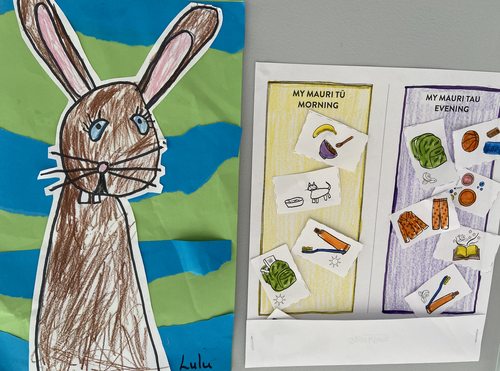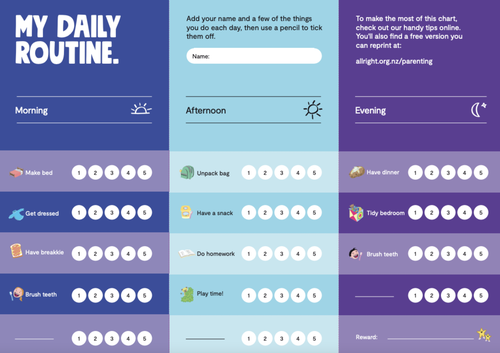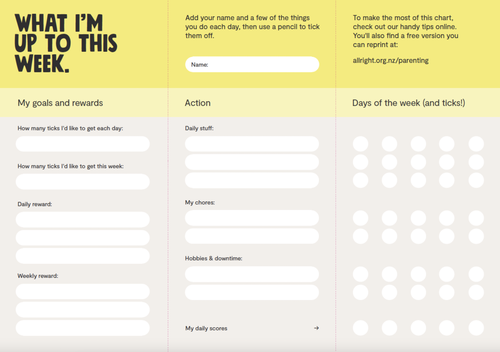How to use your routine chart - younger tamariki
If you’re keen to introduce a chart, we’d suggest discussing it with your child the afternoon or night before you have a day at home together and can practice.E.g. You might talk about it on Saturday, then give it a go on Sunday – when you can work through it together, offer lots of praise and help them understand what’s expected.
To get the ball rolling:
- Start by chatting with your child about the chart in a really positive way. E.g."Sometimes our mornings can be a little tricky, eh?” Feel free to acknowledge if you’ve been grumpy or any other stuff your child might like changed. It all helps with buy-in! Take them through the chart as a solution to this..
- Emphasise ‘ticking off’ the activities (or removing them if using the DIY chart) as they complete them.
- An important note for you is to be aware of your expectations, - bed making will NEVER be as neat as you do them! Let that go for now, you’ll have more success if you give them praise for their effort and steps they’re taking, than getting it perfect.
- And notch up the praise alongside your chart! High five them on their way to brush their teeth, thank them for making their bed, tell them you really appreciate their efforts to help out, and give them a hug and sticker when they have a run of ticks.
- Keep it positive and fun! Everyone wants to be where the fun is at. And keep it consistent. If you lose interest, they will too.
When to use an extra incentive?
If the old ‘praise and stickers’ approach just isn’t cutting the mustard, you may like to introduce a rewards system to boost engagement.Rewards could be gained after a week of consistent effort or a certain number of ticks (15 or 20 to begin) or stickers.
- Let them choose from a range of low cost rewards, such as:
- A favourite activity with you
- A visit to the museum, park, beach or art gallery
- A friend over for a sleepover
- Sleeping in a hut you've built in the lounge
- An ‘at home’ movie with popcorn
Needing to change it up?
Eventually, you may find you don’t need your daily chart. Hurrah!! Or, more likely, you’ll find you don’t need it for a while, then suddenly… you do again! Don’t panic. This is very normal. Even as adults we sometimes get busy, forget to do stuff, and need revert to those good ol’ to-do lists.If your child wants to make their own daily chart – do it! Get out the pens, paper and glitter – or let them decorate a free chart you find online. Engage them in whatever way you can.And don’t be afraid to change up your daily chart as the seasons, or their needs and routines change.
Getting the routine sorted for older tamariki
Follow the guide above taking into account the following:
- Chances are our older tamariki been getting busier with homework, activities and friends. Praise the things they already do well and explain that to the a routine chart can help keep on top of stuff, without stress
- Gauge their ‘willingness’! If it’s not immediate, ask them to think about what they could put on it and come back to it in a day or so.
- If they’re into it, strike while the iron is hot! Chat about the things they need time for most days, or what they’d like to be putting more energy into, and emphasise the downtime aspect. This is hugely important for our kid's development and wellbeing and it’s easy to overlook.
- Suggest at least one (max three) household jobs they can help with each day/week. Let them know what a great help that is, and slip in that having chores as a young person tends to make us more successful adults. (It’s true.. research has found a correlation!)
We’d suggest ‘trying out’ the daily chart for a week, then reviewing it. That way you can both tweak it as you need to – there’s nothing worse than feeling like you’ve failed the first time around.
When to use incentives and rewards
Generally if you notch up the encouragement and praise alongside your routine chart, this might keep your kid motivated - as well as them experiencing the positive results of having the chart in place.But, as you’ve probably discovered, our older kids are incredibly talented at asking: ‘What’s in it for me?’ So be prepared! What no (or low) cost rewards could you offer? What might appeal to them? We recommend they choose from a list you provide, adding a new item or two over time, as agreed by you.Your list might include:
- A ‘stay up later’ night
- A chai latte date with you or a friend
- A movie night in (with popcorn or a treat)
- An activity you like to do together, whether it’s mountain biking, doing your nails, going for a hike, reading magazines or sleeping on pillows in the lounge.
- Having extra time with a friend (or a sleepover)
- Getting something new for their room – a cushion, noticeboard
- Some pocket money – perhaps combine this with an online bank account so they can ‘learn’ about saving (but don’t make this the focus!).
- Finally, encourage your teen to take ownership. This is their chart – not yours. And tell them how great it is that they’re leading the way.
Where you can, be positive, interested and encouraging – supporting their efforts as much as the results. Just like younger children, they probably won’t do things to the same standard you might, or in the order you would. And yes… they’re likely to forget things, skip things and not always get it right. (Heck, who does!?)Rather than focus on the slips, help them regroup and get back into it. It’s a great chance to teach them perseverance and that ongoing effort is more important than obsessing with perfection.



